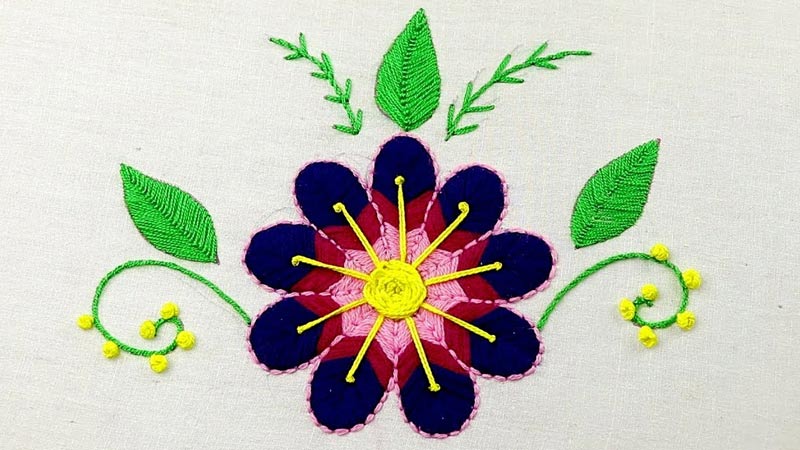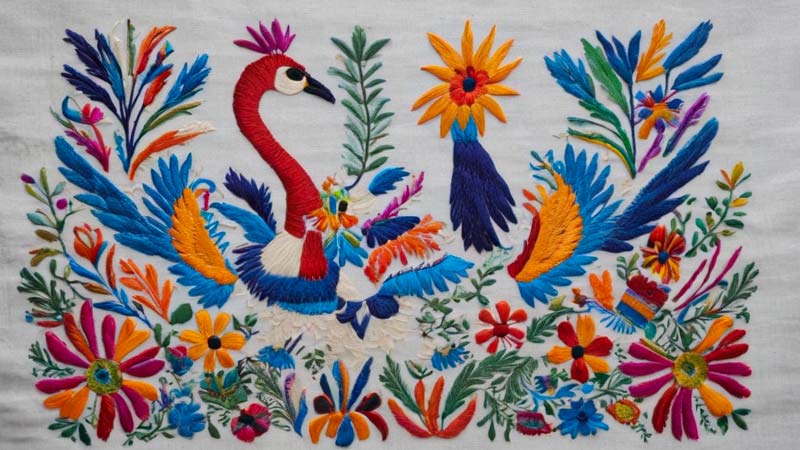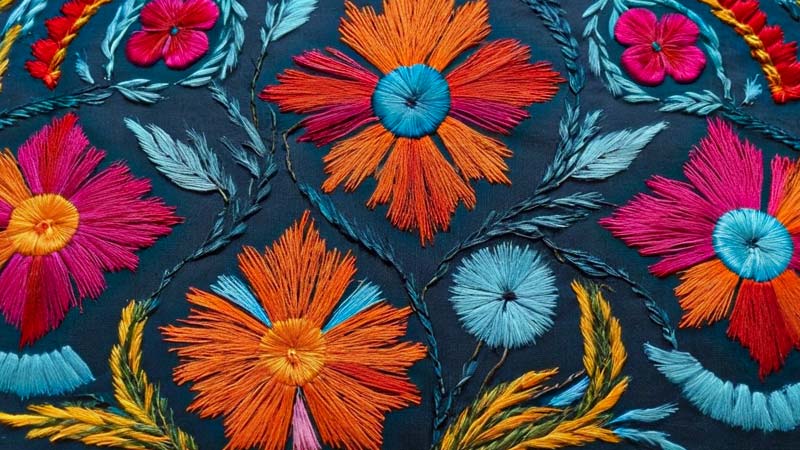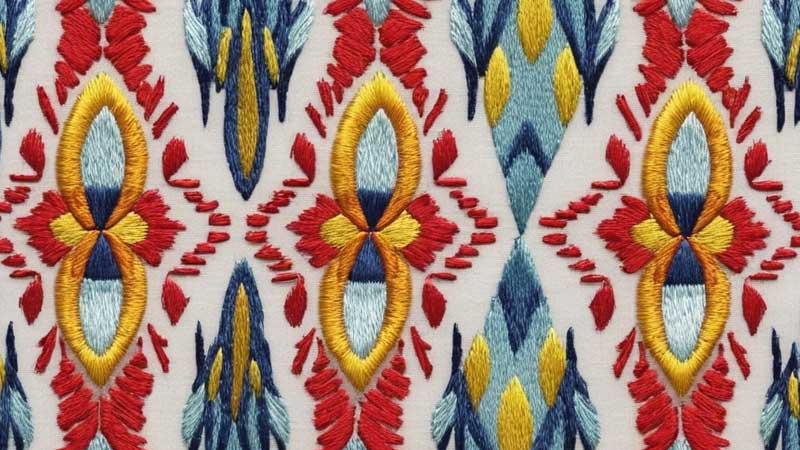Traditional Mexican embroidery is a captivating art form that encapsulates the vibrant cultural tapestry of Mexico.
Known for its intricate designs, rich symbolism, and regional diversity, Mexican embroidery is a testament to the country’s indigenous heritage and artistic prowess.
The diverse styles bear distinct names based on their cultural origins, showcasing unique techniques and motifs.
From the vivid Otomi embroidery with its colorful depictions of animals and plants to the earthy tones of Zapotec embroidery echoing nature and the symbolic richness of Chiapas embroidery, the names carry the essence of their cultural roots.
This introduction sets the stage for a journey into traditional Mexican embroidery, where each stitch weaves a story of tradition and craftsmanship.

Mexican Embroidery History
Mexican embroidery boasts a rich history that dates back centuries, intertwining indigenous craftsmanship with colonial influences.
Pre-Columbian cultures, such as the Aztecs and Maya, practiced intricate textile arts, laying the foundation for embroidery traditions.
The arrival of Spanish colonizers introduced new materials and stitching techniques, blending European influences with indigenous styles.
Over time, regional variations emerged, each with its unique motifs and colors, reflecting the cultural diversity of Mexico.
Embroidery became integral to traditional attire, with garments like huipils and scrapes serving as canvases for artistic expression and cultural identity.
The resilience of Mexican embroidery is evident in its ability to adapt and evolve, preserving ancient techniques while embracing contemporary designs.
This vibrant heritage continues to thrive today, with skilled artisans passing down their craft through generations, ensuring that Mexican embroidery remains a timeless symbol of cultural pride and artistic ingenuity.
What Is Traditional Mexican Embroidery Called?

Traditional Mexican embroidery is often referred to as “Tenangos,” showcasing the country’s rich cultural tapestry.
Renowned for its vibrant colors and intricate designs, Tenangos are a distinctive form of Otomi embroidery originating from the Otomi indigenous communities in central Mexico.
These exquisite textiles feature unique floral and animal motifs with deep symbolic meanings, reflecting the connection between nature and spirituality in Mexican culture.
The artistry of traditional Mexican embroidery extends beyond Tenangos, encompassing a variety of regional styles such as the intricate cross-stitching of Chiapas and the geometric patterns of Oaxaca.
Each region contributes to the diverse tapestry of Mexican embroidery, celebrating the country’s history and indigenous heritage.
Through the skillful hands of artisans, this time-honored craft continues to thrive, preserving Mexican embroidery’s beauty and cultural significance for generations to come.
Types of Mexican Embroidery
Mexican embroidery is a rich and diverse craft that reflects the country’s vibrant cultural heritage. Each region in Mexico boasts its unique style of embroidery, characterized by distinct techniques, motifs, and color palettes.
Here are the notable types of Mexican embroidery:
1. Otomi Embroidery (Tenango Embroidery)

Originating from the Otomi people in the central Mexican region, Otomi embroidery, also known as Tenango embroidery, is celebrated for its vivid and elaborate designs.
The artisans combine animals, plants, and geometric shapes to create visually stunning compositions. Birds, rabbits, and native flora are recurring motifs, often arranged in symmetrical patterns.
Otomi embroidery is characterized by its bold and bright colors, creating a striking contrast against the plain background, typically in white or neutral tones.
The intricate stitches showcase the artisan’s skill and attention to detail, making each piece a unique work of art.
2. Zapotec Embroidery
Hailing from the Zapotec indigenous communities in Oaxaca, Zapotec embroidery is distinguished by its connection to nature and the use of natural fibers.
Earthy tones dominate the color palette, reflecting the landscape of the region. Designs often depict stylized animals, plants, and symbolic representations of local geography.
The embroidery is commonly applied to garments like blouses and dresses, integrating traditional patterns that tell stories of the Zapotec culture.
The meticulous craftsmanship and use of local materials contribute to the authenticity and uniqueness of Zapotec embroidery.
3. Chiapas Embroidery
The state of Chiapas is a treasure trove of diverse embroidery styles, with each community contributing its distinctive touch.
For instance, the Tzotzil and Tzeltal communities are known for their vibrant and multicolored textiles adorned with intricate patterns.
Chiapas embroidery frequently incorporates Mayan symbols and traditional motifs, reflecting the deep cultural roots of the region.
The use of bold colors and complex designs adds to the visual richness of Chiapas embroidery, showcasing the artistry and storytelling embedded in each stitch.
4. Puebla Embroidery (Tehuana Embroidery)
Tehuana embroidery, originating from the Tehuantepec Isthmus region in the state of Oaxaca, is a testament to the exquisite craftsmanship of its artisans.
Characterized by intricate floral motifs and detailed embellishments, Tehuana embroidery is often featured prominently in the traditional Tehuana costume. The heavily embroidered blouses and skirts showcase the skill and dedication of the artisans.
The use of floral patterns symbolizes the connection to nature, and the vibrant colors contribute to the overall festive and celebratory aesthetic of Tehuana embroidery.
5. Huatulco Embroidery

In Oaxaca’s coastal region, Huatulco embroidery draws inspiration from the marine environment.
Designs often incorporate marine life, shells, and other coastal elements, creating a unique visual narrative.
Unlike some other styles, the color palette in Huatulco embroidery is more subdued, reflecting the natural hues of the ocean and beach.
This style captures the essence of the coastal lifestyle, making it a distinctive and culturally significant expression for the local communities.
6. Yucatecan Embroidery
Originating from the Yucatán Peninsula, Yucatecan embroidery is characterized by its delicate and fine stitches.
Traditional huipiles (embroidered blouses) are adorned with intricate floral and fauna motifs, showcasing the artisans’ attention to detail.
The color palette in Yucatecan embroidery is typically lighter and more pastel-toned, creating a soft and elegant aesthetic.
The embroidery serves as a form of artistic expression and reflects the region’s tropical landscape and cultural identity.
7. Nahuatl Embroidery
Connected to the Nahuatl-speaking communities, particularly in central Mexico, Nahuatl embroidery stands out for its bold geometric patterns and stylized representations of nature.
Using vibrant colors and symmetrical designs adds a visually striking element to this style. Each pattern often carries symbolic significance, conveying stories from Nahuatl traditions and mythology.
Nahuatl embroidery is a vibrant and dynamic expression of the cultural heritage of the communities that practice it.
8. Mazahua Embroidery
Hailing from the Mazahua indigenous communities in the State of Mexico and surrounding areas, Mazahua embroidery is characterized by its vibrant colors and intricate floral patterns.
The artisans skillfully apply their craft to blouses, skirts, and other traditional garments, creating functional and visually captivating pieces.
The bright colors and detailed designs often carry cultural significance, reflecting the connection between Mazahua communities and their natural surroundings.
Mazahua embroidery is a testament to the community’s rich heritage and the creativity of its artisans.
Mexican Textile Patterns
Mexican textile patterns are a vivid and diverse reflection of the country’s rich cultural heritage, blending indigenous traditions with historical influences.
These patterns, often embedded with symbolic meanings, showcase the artistry and craftsmanship of Mexican artisans.
Some notable Mexican textile patterns include:
Ikat Patterns

In Mexico, the art of ikat, known as “jaspeado,” is a mesmerizing dance of color and technique. Threads are resist-dyed before weaving, resulting in blurred, intricate patterns that captivate the eye.
Particularly prominent in regions like Oaxaca, ikat patterns exhibit a harmonious blend of geometric shapes and vibrant hues.
The meticulous craftsmanship in creating these visually stunning designs showcases the skill of Mexican artisans.
Ikat textiles, with their dynamic and fluid patterns, serve as a testament to the cultural richness and artistic ingenuity of Mexican textile traditions.
Serape Patterns
Serapes, originating from the Mexican state of Coahuila, are not merely blankets or shawls but vibrant expressions of Mexican culture.
Characterized by bold stripes and geometric patterns, serape designs often incorporate traditional Zapotec motifs, reflecting the indigenous roots of the craft.
These colorful textiles have transcended their utilitarian origins to become iconic symbols of Mexican identity.
The juxtaposition of bright, contrasting colors creates a lively visual impact, making serapes aesthetically pleasing and culturally significant.
Oaxacan Black Clay Textiles
Indigenous communities in Oaxaca, notably the Mixtec, and Zapotec, contribute to the rich tapestry of Mexican textiles with their intricate black clay creations.
These textiles feature geometric patterns and intricate black or dark brown embroidery against a natural or white background, creating a captivating contrast.
Black clay adds a unique texture and depth to the designs, emphasizing the artisan’s attention to detail.
Rooted in tradition and culture, Oaxacan black clay textiles are aesthetically striking and carry the stories and heritage of the communities that craft them.
Amuzgo Textiles
Hailing from the Guerrero region, Amuzgo textiles are a testament to the meticulous craftsmanship of indigenous artisans.
Handwoven with intricate designs using backstrap looms, these textiles feature patterns incorporating geometric shapes, animals, and human figures. Vibrant colors are a hallmark, reflecting the lively spirit of the Amuzgo people.
Amuzgo textiles are not just fabric; they are visual narratives, weaving stories of cultural identity and the artistic heritage of the Guerrero region into each thread.
Huilango Textiles
Huilango textiles from the Nahua community celebrate vibrant colors and meticulous patterns.
Woven on traditional backstrap looms, these textiles showcase intricate designs, including representations of animals, plants, and geometric shapes.
The visually captivating patterns reflect the artisan’s skill and creativity, making each piece a unique work of art.
Huilango textiles serve as a canvas for cultural expression, embodying the traditions and stories of the Nahua community in every carefully crafted stitch.
Mexican Embroidery Patterns
Mexican embroidery is a kaleidoscope of regional styles, each with distinctive patterns. Otomi embroidery stands out with its elaborate depictions of animals and plants, embodying the region’s biodiversity.
Chiapas embroidery incorporates Mayan symbols, weaving stories of ancient civilizations into the fabric.
Tehuana embroidery from Puebla showcases intricate floral motifs, symbolizing the deep connection to nature.
These embroidery patterns serve as expressions of creativity and cultural artifacts, preserving and transmitting the rich tapestry of Mexican heritage.
Huipil Patterns
Huipils, traditional embroidered blouses worn by indigenous women, carry diverse patterns reflecting regional identities. Yucatecan huipils may feature delicate floral and fauna motifs, reflecting the tropical landscape.
Mazahua huipils often showcase intricate floral patterns in vibrant colors, representing the artistic expression of the Mazahua community.
Each stitch in a huipil tells a story, capturing the essence of the culture and history embedded in these traditional garments.
Zapotec Rug Patterns
The finely crafted wool rugs, or “tapetes,” of the Zapotec people are more than floor coverings; they are works of art inspired by mythology and landscape.
These rugs feature geometric patterns and symbols, each design telling a story deeply rooted in Zapotec culture.
From the intricate depictions of animals to the symbolic representations of the surrounding environment, Zapotec rug patterns are a testament to the artisan’s storytelling ability.
These textiles enhance living spaces and serve as cultural artifacts, preserving Zapotec traditions in a visually captivating form.
FAQs
What Is Mexican Embroidery Called?
Mexican embroidery goes by regional names such as Otomi embroidery, Chiapas embroidery, and Tehuana embroidery, each with distinct styles and cultural influences.
How Is a Mexican Embroidered Shirt?
A Mexican embroidered shirt, like a huipil or blusa bordada, features intricate regional embroidery on lightweight fabric, reflecting the unique style of each region.
What Is Mexican Floral Embroidery?
Mexican floral embroidery incorporates vibrant depictions of flowers and plants, symbolizing the region’s flora.
Seen in Chiapas embroidery and Yucatecan huipils, it adds aesthetic beauty and cultural significance to textiles.
What is Mexican Otomi?
Mexican Otomi refers to the vibrant and intricate embroidery style from the Otomi indigenous communities in central Mexico, featuring colorful depictions of animals and plants on a plain background.
To Recap
Traditional Mexican embroidery, known by various regional names such as Otomi embroidery, Chiapas embroidery, and Tehuana embroidery, encapsulates Mexico’s artistic essence and cultural diversity.
These distinct styles, each with unique motifs and techniques, serve as vibrant threads woven into the rich tapestry of Mexican textile traditions.
From the intricate depictions of animals and plants to the symbolic representations of ancient civilizations, traditional Mexican embroidery celebrates heritage, creativity, and storytelling.
The cultural significance embedded in every stitch reflects the resilience and continuity of Mexico’s indigenous crafts, ensuring that these time-honored traditions endure as living expressions of the country’s identity.
Leave a Reply